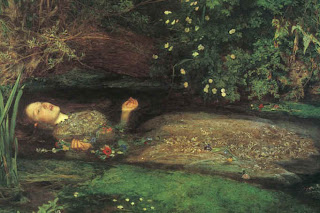Millais (Tate Britain)
 Millais rehabilitated?
Millais rehabilitated?Does the Tate’s attempt at the rehabilitation of Millais work? The jury’s not out on this one, it doesn’t. In fact it reinforces the already set view that his place is as an excellent, but ultimately not world class, English, Victorian painter.
Try as they may in the catalogue and picture notes, only hopeless English romantics would see Millais as anything other than a Victorian cul-de-sac, albeit lined with a few fine paintings and some wonderful technique.
Take the catalogue, “Millais works can now be seen to function powerfully in the cultured diversity of the modern
Most of his paintings remain in
Like marquetry
The early paintings show his precocity and Pizarro and the Incas at 16! is astonishing. Christ in the House of his Parents and Isabella are fine works but have that cardboard cut-out look that makes his works look like marquetry. Everything’s just a little too obvious and well delineated.
Millais  – erotic!
– erotic!
There’s a futile attempt to juice him up by much talk of ‘veiled eroticism’ and ‘erotic longing’ in Ophelia and Mariana but it’s all a little too tame. Ophelia is a stunning image, memorable, but ultimately, a pretty and pretty unrealistic image. Mariana is over-produced with its stained glass windows and objects distracting from the subject – her pose. Nevertheless, this is one of the better paintings in the show. It could have been nicely paired with the later portrait of the woman in the chiffon dress. Both are back views where the subject’s gains erotic presence through what is not shown. It was interesting to read more on Millais affair and ultimate marriage to Ruskin’s wife, the divorce granted on the grounds of the non-consummation! Even for Ruskin this was taking aesthete behaviour a little too far.

His Highlander image is too maudlin for words and suits the tendency for the Scots to romanticise their history perfectly. It’s an image that sums up
Factory production
The Blind Girl is a hideous image as is the Eve of St Agnes, his oddball incident paintings, fire-fighter, North-West passage etc. His later work (apart from the Scottish landscapes) descends into factory production Victorian portraits that reflect nothing more than the vanity and commercial transactions that they were. In the end his legacy remains within


0 Comments:
Post a Comment
<< Home